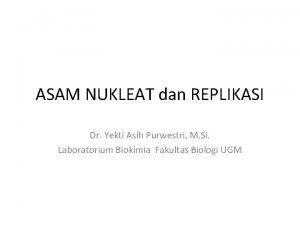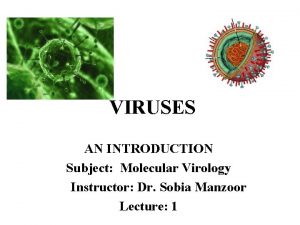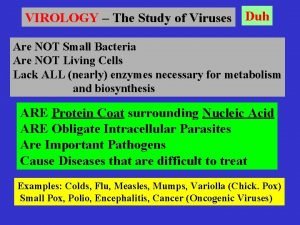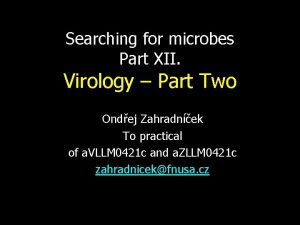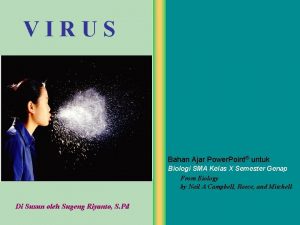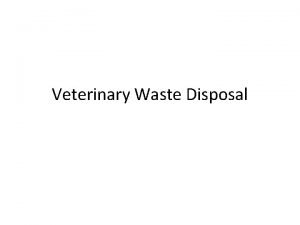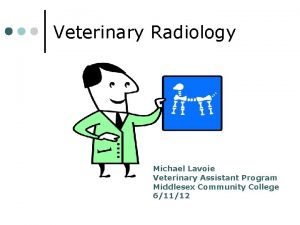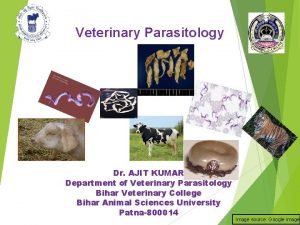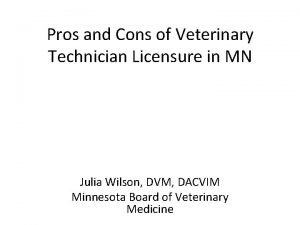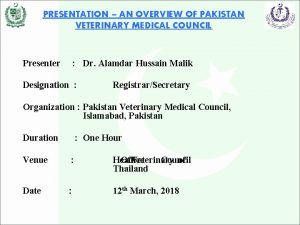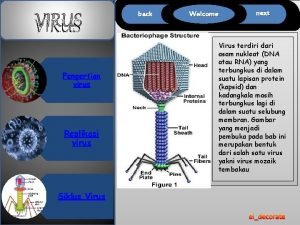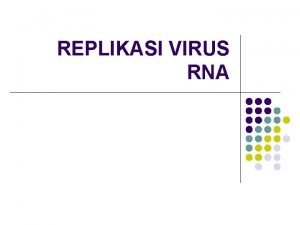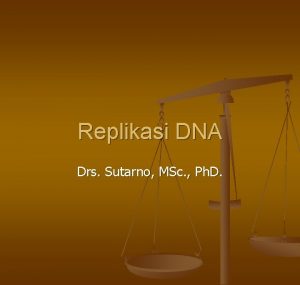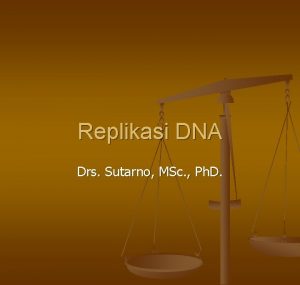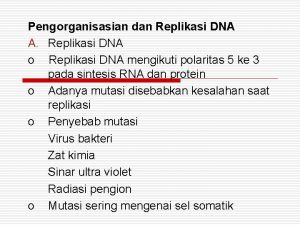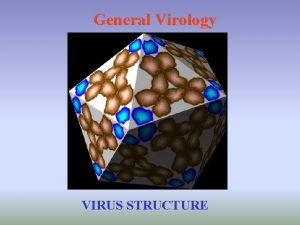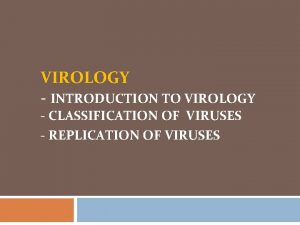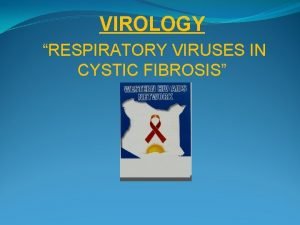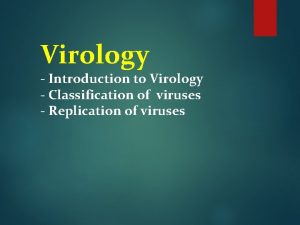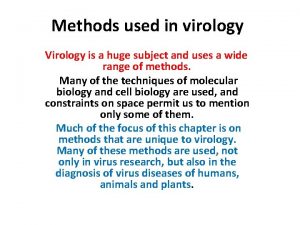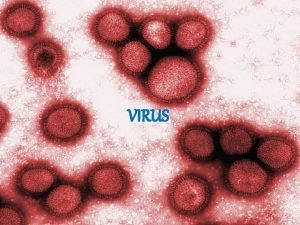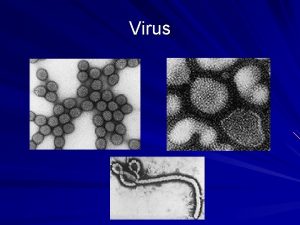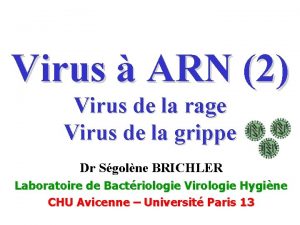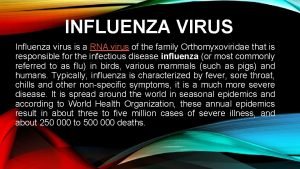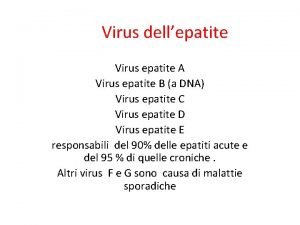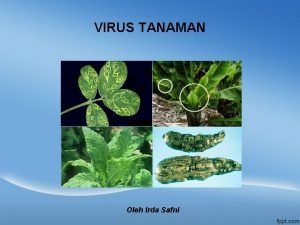REPLIKASI VIRUS Chapter 3 Veterinary Virology Pendalaman Tentang




















- Slides: 20

REPLIKASI VIRUS Chapter 3 Veterinary Virology

Pendalaman Tentang Replikasi Virus dan Animasinya dapat anda akses melalui situs : • http: //darwin. bio. uci. edu/~faculty/wagner/mov ieindex. html • http: //www. blackwellpublishing. com/wagner/an imation. asp# • Merupakan mekanisme yang kompleks tapi menarik

Replikasi Masih ingat ! : • Virus hanya dapat bereplikasi bila dia hidup dalam sel yang hidup. • Namun tidak semua sel dapat menjadi media replikasi bagi virus-virus tertentu. • Agar dapat melakukan perlekatan (attachment) baik virus maupun sel harus memiliki hubungan yaitu adanya reseptor pada bagian sel dan ligan (complementarity) di bagian virusnya sehingga akhirnya virus dapat melekat! Ada kecocokan

Replikasi • Adanya kecocokan tersebut yang menyebabkan adanya pembatasan inang dari masing virus Artinya : virus yang memil; iki tempat perlekatan yang sanagt spesifik haya akan berrpklikasi pada rentang sel inang yang sempit! Sebagai contoh : feline viral rhinotracheitis virus hanya bisa bereplikasi di sel yang berasal dari feline. Sementara itu ada virus-virus tertentu memiliki inang sangat luas ( macam-macam hewan) contohnya virus eastern equine encephalomyelitis, virus ini dapat bereplikasi pada sel hewan asal burung, nyamuk, ular, kuda dan manusia karena kemampuan perlekatan virus ini pada sel-sel diatas

ATTACHMENT PENETRATION UNCOATING HOST FUNCTIONS Transcription Translation VIRAL LIFE CYCLE REPLICATION ASSEMBLY (MATURATION) RELEASE Replication

ATTACHMENT ( perlekatan) : • Bagaian virus yang menempel/melekat ke membran sel mengandung protein virus attachment yang bersifat sangat spesifik (VIRAL ATTACHMENT PROTEIN /V. A. P. ) terhadap RESEPTOR dari membran sel. • Molekul Reseptor dapat berupa protein umumnya glycoproteins - specific molecules, atau residu gula yang ada di molekul glycoproteins atau glycolipids (less specific). Dua jenis interksi antara VAP dengan reseptor yang banyak dipelajari contohnya :

ATTACHMENT ( perlekatan) : • Beberapa virus yang bersifat kompleks (e. g. Poxviruses, Herpesviruses) bisa memiliki lebih dari satu receptor/receptor-binding protein, oleh karenanya memiliki beberapa alternatif masuknya virus kedalam sel. • Specific receptor binding side dapat juga ditempeli oleh antibodi spesifik yang telah tertempeli partikel –partikel virus di bagian Fc reseptor dari permukaan sel monosit, kondisi ini juga menyebabkan virus ditelan

ATTACHMENT ( perlekatan) : • Ada tidaknya reseptor dipermukaan sel sebagian besar dideterminasikan sebagai suatu TROPISM (kesukaan) dari beberapa virus, misalnya pada beberapa tipe sel yang membuat virus dapat bereplikasi berperan penting sebagai faktor patogenesa virus tersebut. • Attachment pada beberapa kasus bersifat dapat balik(reversible), bila penitrasi tidak dapat terjadi virus dapat dilepaskan dari permukaan sel. Beberapa virus seperti virus influenza mempunyai mekanisme spesifik untuk melepaskan diri dari sel dengan adanya enzim neuramidase, tetapi pelepasa dari sel ini menyebabkan perubahan pada permukaan virus yang berakibat penurunan kemampuan virus untuk menempel lagi pada sel lain

2. PENETRASI(PENITRATION): Ada tiga model penitrasi yaitu : Endocytosis, mekanisme masuknya virus melalui engulfment dari virus dalam vacuola fagositik, mekanisme umum pada virus hewan. Fusion mekanisme ini terjadi pada virus beramplop dimana lapisan amplopnya bersatu dengan membran plasma sel kemudian nucleocapsid dilepas masuk ke sitoplasma . Fusi antara amplop virus dengan membran sel memerlukan protein fusi virus yang ada diamplop contohnya heamagglutinin pada virus influenza dan glikoprotein amplop pada retrovirus. Direct penetration (translocation), virus masuk melalui pori dari membran plasma sel, mekanisme ini terjadi pada picornaviruses and reoviruses. Pada translokasi ini seluruh virion masuk melewati membran sel.

UNCOATING Contoh uncoating pada virus yg strukturnya sederhana : • Picornaviruses mempunyai protein dasar yang kecil ~23 amino acids (Vp. G) secara kovalen melekat pada ujung 5' dari v. RNA genome Contoh uncoating pada virus yang strukturnya kompleks: • Kapsid Retrovirus sanagt kompleks yang mengandung enzim reverse transcriptase yang bertanggung jawab mengkonversi viral RNA genome menjadi DNA PROVIRUS. Proses tersebut terjadi didalam partikel virus (kapsid). • Virus-virus yang bereplikasi disitoplasma e. g. Picornaviruses, genomenya dengan mudah dilepas masuk ke sel, tetapi virus yang Bereplikasi dinukleus e. g. Herpesviruses, genomnya berasosiasi dengan nucleoproteins, yang harus ditranspor ke membran nukleus. Transport tersebut merupakan hasil interaksi antara nucleoproteins (or capsid) dengan cytoskeleton. Di pori nukleus kapsid akan dilucuti sehingga genom bisa masuk ke nukleus.

REPLIKASI GENOM Strategi replikasi masing-masing virus tergantung kondisi alami genomnya. Diklasifikasikan dalam tujuh kelompok model replikasi : • I: Double-stranded DNA (Adenoviruses; Herpesviruses; Poxviruses, etc) • II: Single-stranded (+)sense DNA (Parvoviruses) • III: Double-stranded RNA (Reoviruses; Birnaviruses) • IV: Single-stranded (+)sense RNA (Picornaviruses; Togaviruses, etc) • V: Single-stranded (-)sense RNA (Orthomyxoviruses, Rhabdoviruses, etc) • VI: Single-stranded (+)sense RNA with DNA intermediate in lifecycle (Retroviruses) • VII: Double-stranded DNA with RNA intermediate (Hepadnaviruses)

Replikasi virus DNA

Replikasi virus DNA Class II: Single-stranded (+)sense DNA (Parvoviruses): • Replikasi terjadi di nucleus, melibatkan pembentukan suatu utas (-)sense yang bertindak sebagai template bagi dibuatnya utas (+)sense.

Replikasi virus DNA Class VII: Double-stranded DNA with RNA intermediate (Hepadnaviruses): • Kelompok virus ini memerlukan enzim reverse transcriptase, tetapi tidak seperti Retrovirus, pembentukan RNA intermediate terjadi dalam partikel virus saat proses maturasi. Saat menginfeksi sel inang baru, genom virus akan memperbaiki gap yang ada dan melanjtkannya dengan proses transkripsi. • Agar replikasi genomberlangsung sukses, virus mempresentasikan m. RNAke sel inang dan selanjutnya di translasi menjadi protein virusdengan beberapa cara : – d/s DNA viruses release their genome into the nucleus and rely on the cellular machinery for transcription. – (+)sense RNA viruses have genomes which serve directly as m. RNA (except retroviruses!) – (-)sense RNA viruses must carry with them virus-coded enzymes for RNA-dependent RNA replication, since uninfected cells do not posses these enzymes.

Replikasi virus DNA 5. TRANSLASI Translasi m. RNAs mejdai protein berlangsung di sitoplasma di ribosom dan dihasilkan protein struktural dan protein kontrol dari virus.

Replikasi virus DNA 6. REPLIKASI • Replikasi asam inti (NA) virus terjadi dinucleus, kecuali iridovirus dan poxvirus. In these, the NA replicates in the cytoplasm so that DNA synthesis and viral protein synthesis occur in a common cytoplasmic factory. • Cellular DNA polymerase is involved in replication of viral NA, except for the larger DNA viruses which code for their own DNA polymerase Control of viral replication is achieved by tight regulation of gene expression. The methods used depend on nature of the virus genome/replication strategy, e. g: Segmented genomes are usually transcribed to produce monocistronic m. RNAs. One advantage of monocistronic m. RNAs is that various proteins can be produced in different amounts, rather than in a constant ratio.

7. ASSEMBLY/PERAKITAN Involves the assembly of all the components necessary for the formation of the mature virion at a particular site in the cell. During this process, the basic structure of the virus is formed. The site of assembly varies for different viruses, e. g: Picornaviruses, Poxviruses, Reoviruses - In the cytoplasm. Adenoviruses, Papovaviruses, Parvoviruses - In the nucleus. Retroviruses - On the inner surface of the cell membrane.

Replikasi virus DNA MATURATION • The stage of the life-cycle at which the virus becomes infectious. Usually involves structural changes in the particle, often resulting from specific cleavage of capsid proteins to form the mature products, which frequently leads to a conformational change in the capsid, or the condensation of nucleoproteins with the genome. For some viruses, assembly and maturation are inseparable, whereas for others, maturation may occur after the virus particle has left the cell.

Replikasi virus DNA 8. RELEASE The DNA viruses are released mainly by cytolysis. Herpesviruses bud from the nuclear membrane into channels that lead to intercellular spaces. • Since most DNA viruses, except poxviruses and iridoviruses, use cellular DNA transcriptases and polymerases, their extracted DNA can be infectious under favorable conditions. Poxviruses require their own virion-associated enzymes for multiplication, hence their extracted DNA in the absence of these enzymes is not infectious.

Replikasi virus DNA • For lytic viruses (most non-enveloped viruses), release is a simple process - the cell breaks open and releases the virus. • Enveloped viruses acquire the lipid membrane as the virus buds out through the cell membrane. Virion envelope proteins are picked up during this process as the virus is extruded. Budding may or may not kill the cell, but is controlled by the virus - the physical interaction of the capsid proteins on the inner surface of the cell membrane forces the particle out through the membrane:
 Virusmax
Virusmax Replikasi dna
Replikasi dna Struktur dna
Struktur dna Introduction to medical virology
Introduction to medical virology Growth curve of virus
Growth curve of virus Virology
Virology Fields virology
Fields virology Fields virology
Fields virology Kurik maksud
Kurik maksud Konsep dan pendalaman materi pembelajaran berorientasi hots
Konsep dan pendalaman materi pembelajaran berorientasi hots Peta konsep materi virus
Peta konsep materi virus Ppt virus kelas x kurikulum 2013
Ppt virus kelas x kurikulum 2013 Veterinary medical abbreviations
Veterinary medical abbreviations Veterinary waste
Veterinary waste Veterinary radiology middlesex county
Veterinary radiology middlesex county Father of veterinary parasitology
Father of veterinary parasitology Veterinary medicines directorate
Veterinary medicines directorate Zuku review bcse
Zuku review bcse Veterinary nurse conduct and discipline rules 2014
Veterinary nurse conduct and discipline rules 2014 Pros and cons of being a veterinary technician
Pros and cons of being a veterinary technician Pvmc registration form
Pvmc registration form


